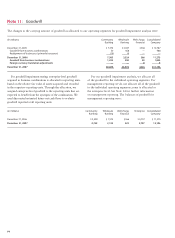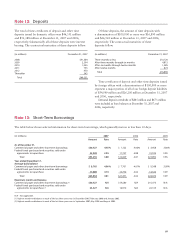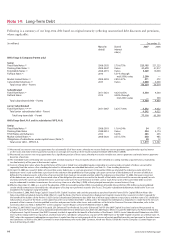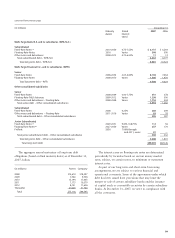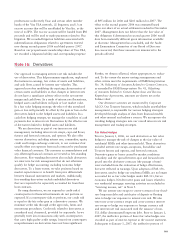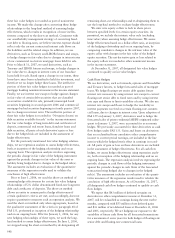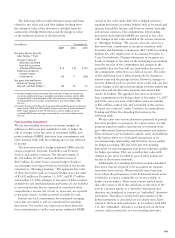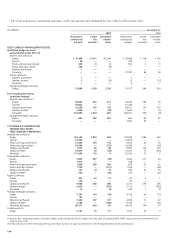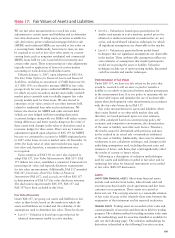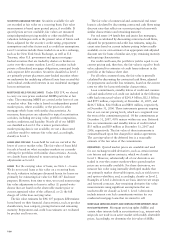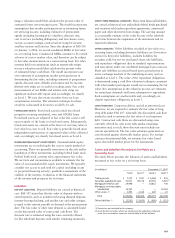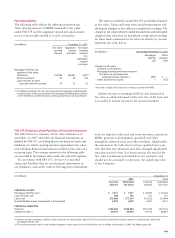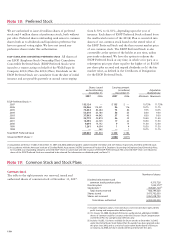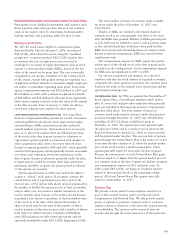Wells Fargo 2007 Annual Report Download - page 109
Download and view the complete annual report
Please find page 109 of the 2007 Wells Fargo annual report below. You can navigate through the pages in the report by either clicking on the pages listed below, or by using the keyword search tool below to find specific information within the annual report.106
The fair value of commercial and commercial real estate
loans is calculated by discounting contractual cash flows using
discount rates that reflect our current pricing for loans with
similar characteristics and remaining maturity.
For real estate 1-4 family first and junior lien mortgages,
fair value is calculated by discounting contractual cash flows,
adjusted for prepayment and credit loss estimates, using dis-
count rates based on current industry pricing (where readily
available) or our own estimate of an appropriate risk-adjusted
discount rate for loans of similar size, type, remaining maturity
and repricing characteristics.
For credit card loans, the portfolio’s yield is equal to our
current pricing and, therefore, the fair value is equal to book
value adjusted for estimates of credit losses inherent in the
portfolio at the balance sheet date.
For all other consumer loans, the fair value is generally
calculated by discounting the contractual cash flows, adjusted
for prepayment and credit loss estimates, based on the current
rates we offer for loans with similar characteristics.
Loan commitments, standby letters of credit and commer-
cial and similar letters of credit not included in the following
table had contractual values of $241.9 billion, $12.5 billion
and $955 million, respectively, at December 31, 2007, and
$216.5 billion, $12.0 billion and $801 million, respectively,
at December 31, 2006. These instruments generate ongoing
fees at our current pricing levels, which are recognized over
the term of the commitment period. Of the commitments at
December 31, 2007, 40% mature within one year. Deferred
fees on commitments and standby letters of credit totaled
$33 million and $39 million at December 31, 2007 and
2006, respectively. The fair value of these instruments is
estimated based upon fees charged for similar agreements.
The carrying value of the deferred fees is a reasonable
estimate of the fair value of the commitments.
DERIVATIVES Quoted market prices are available and used
for our exchange-traded derivatives, such as certain interest
rate futures and option contracts, which we classify as
Level 1. However, substantially all of our derivatives are
traded in over-the-counter markets where quoted market
prices are not readily available. For those derivatives, we
measure fair value using internally developed models that
use primarily market observable inputs, such as yield curves
and option volatilities, and, accordingly, classify as Level 2.
Examples of Level 2 derivatives are basic interest rate swaps
and forward contracts. Any remaining derivative fair value
measurements using significant assumptions that are
unobservable we classify as Level 3. Level 3 derivatives
include interest rate lock commitments written for our
residential mortgage loans that we intend to sell.
MORTGAGE SERVICING RIGHTS AND CERTAIN OTHER INTERESTS HELD
IN SECURITIZATIONS Mortgage servicing rights (MSRs) and
certain other interests held in securitizations (e.g., interest-only
strips) do not trade in an active market with readily observable
prices. Accordingly, we determine the fair value of MSRs
SECURITIES AVAILABLE FOR SALE Securities available for sale
are recorded at fair value on a recurring basis. Fair value
measurement is based upon quoted prices, if available. If
quoted prices are not available, fair values are measured
using independent pricing models or other model-based
valuation techniques such as the present value of future cash
flows, adjusted for the security’s credit rating, prepayment
assumptions and other factors such as credit loss assumptions.
Level 1 securities include those traded on an active exchange,
such as the New York Stock Exchange, as well as U.S.
Treasury, other U.S. government and agency mortgage-
backed securities that are traded by dealers or brokers in
active over-the-counter markets. Level 2 securities include
private collateralized mortgage obligations, municipal bonds
and corporate debt securities. Securities classified as Level 3
are primarily private placement asset-backed securities where
we underwrite the underlying collateral (auto lease receivables)
and residual certificated interests in our residential mortgage
loan securitizations.
MORTGAGES HELD FOR SALE (MHFS) Under FAS 159, we elected
to carry our new prime residential MHFS portfolio at fair
value. The remaining MHFS are carried at the lower of cost
or market value. Fair value is based on independent quoted
market prices, where available, or the prices for other
mortgage whole loans with similar characteristics. As
necessary, these prices are adjusted for typical securitization
activities, including servicing value, portfolio composition,
market conditions and liquidity. Nearly all of our MHFS
are classified as Level 2. For a minor portion where
market pricing data is not available, we use a discounted
cash flow model to estimate fair value and, accordingly,
classify as Level 3.
LOANS HELD FOR SALE Loans held for sale are carried at the
lower of cost or market value. The fair value of loans held
for sale is based on what secondary markets are currently
offering for portfolios with similar characteristics. As such,
we classify loans subjected to nonrecurring fair value
adjustments as Level 2.
LOANS For the carrying value of loans, see Note 1 – Loans.
We do not record loans at fair value on a recurring basis.
As such, valuation techniques discussed herein for loans are
primarily for estimating fair value for FAS 107 disclosure
purposes. However, from time to time, we record nonrecurring
fair value adjustments to loans to reflect (1) partial write-
downs that are based on the observable market price or
current appraised value of the collateral, or (2) the full
charge-off of the loan carrying value.
The fair value estimates for FAS 107 purposes differentiates
loans based on their financial characteristics, such as product
classification, loan category, pricing features and remaining
maturity. Prepayment and credit loss estimates are evaluated
by product and loan rate.


